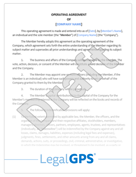What to Do When You Launch a New Digital Product
You’ve poured months into creating an online course, your first digital product, and you’re ready to share it with the world. But the to-do list is...
7 min read
LegalGPS : Jul. 21, 2025
You’ve been selling handmade candles at local markets, and now you’re ready to take your side hustle online. The idea of reaching customers worldwide is thrilling, but the to-do list feels endless: picking a platform, sorting out taxes, building a website, and marketing your products. Starting an online store is an exciting leap, but it’s also a maze of legal, technical, and strategic steps that can overwhelm even the savviest entrepreneur.


Legal GPS Pro
Protect your business with our complete legal subscription service, designed by top startup attorneys.
This step-by-step guide will help you launch your online store with confidence. From choosing a niche to driving your first sales, we’ll cover five key steps, packed with real-world examples and actionable “Pro Tips” to avoid pitfalls and set up for success. Whether you’re a freelancer, startup founder, or small business owner, let’s turn your vision into a thriving ecommerce business.

E-Commerce Terms and Conditions
Get our E-Commerce Terms and Conditions Template to define your sales terms and protect your online business legally.
Trusted by 1,000+ businesses to safeguard their LLCs.
Before diving into website builders or product listings, you need a clear plan. A well-defined niche and a simple business plan lay the foundation for your online store’s success.
Start by picking a niche—products or services that align with your expertise and market demand. Research trending categories, like eco-friendly home goods or pet accessories, using free tools like Google Trends. Narrow your focus to stand out; instead of “jewelry,” target “handmade minimalist necklaces for professionals.” Define your target audience (e.g., millennials, fitness buffs) and your unique selling proposition (USP), like “sustainably sourced materials” or “custom designs under $50.”
Next, draft a basic business plan. Outline your products, startup costs (e.g., $500 for inventory, $30/month for a website), pricing strategy, and revenue goals (e.g., $2,000/month in sales by month six). Estimate ongoing costs, like shipping or marketing, and set a budget. This plan keeps you focused and helps you track progress. The Small Business Administration offers free business plan templates to get started.
Lisa, a part-time crafter, wanted to sell her handmade pottery online. She noticed a surge in demand for minimalist home decor on Instagram and chose to focus on small, affordable ceramic planters for urban dwellers. Her USP was “handcrafted, eco-friendly planters under $30.” Using a simple spreadsheet, she budgeted $1,000 for clay, a website, and initial ads, aiming for $1,500 in monthly sales. Her clear niche and plan led to $2,000 in sales in her first three months.
Explore Google Trends or Instagram hashtags to spot trending products in your niche. For example, search “sustainable fashion” to see rising interest or check competitors’ posts for popular items. These free insights help you pick a niche with proven demand, reducing the risk of launching into a saturated market.
An online store is a real business, so you need to make it official with the right legal and financial setup. This step protects your assets and ensures compliance with regulations.
Choose a business structure. A sole proprietorship is simple but leaves your personal assets (like your savings) at risk if sued. An LLC offers liability protection and is popular for small ecommerce businesses, costing $50–$200 to register with your state. Check your state’s business filing website for forms and fees. Then, get an Employer Identification Number (EIN) from the IRS, which is free and required for taxes or hiring employees.
Apply for necessary permits, like a sales tax permit if your state taxes online sales (most do). Research your state’s revenue department for rules, as some require collecting tax only after hitting a sales threshold (e.g., $100,000 annually). Open a business bank account to separate personal and business finances—most banks offer free accounts for small businesses. Set up a payment processor, like Stripe or PayPal, to accept credit cards, typically charging 2.9% + $0.30 per transaction.
Mike, a fitness coach, started an online store selling resistance bands. He formed an LLC for $100 through his state’s website, protecting his personal savings from business risks. He got a free EIN from the IRS and a sales tax permit, as his state required it for online sales. Mike opened a business checking account and linked it to Stripe for payments. These steps took one week and ensured he was legally compliant and ready to sell.
Meet with a CPA before launching to understand your sales tax obligations and potential deductions, like website costs or inventory expenses. A one-hour consultation ($100–$300) can save you from tax penalties or missed savings. Ask about nexus laws, which determine where you owe sales tax based on sales or shipping locations.
Your online store needs a home, and an ecommerce platform is the easiest way to build one. The right platform balances cost, features, and ease of use to showcase your products.
Compare popular options: Shopify ($39/month) offers user-friendly templates and strong support; WooCommerce (free plugin for WordPress) is customizable but requires more tech know-how; BigCommerce ($39/month) suits scaling businesses with robust inventory tools. Test free trials to find the best fit for your budget and skills. For beginners, Shopify or Wix ($27/month) are low-effort choices.
Design a clean, mobile-friendly store. Use high-quality product photos, write clear descriptions (e.g., “100% organic cotton scarf, 70x20 inches”), and add customer reviews for trust. Create essential pages: Home, About (your story), Contact, and Returns Policy. Ensure checkout is simple, with options like guest checkout to reduce cart abandonment. Test your site on mobile, as over 50% of ecommerce traffic comes from phones.
Sarah wanted to sell vintage-inspired clothing but had no coding skills. She chose Shopify for its drag-and-drop builder and $39/month plan. Using a free template, she uploaded professional photos, wrote detailed product descriptions, and added a “30-day returns” page. Her mobile-optimized store launched in two weeks, earning $1,200 in sales in month one, thanks to its clean design and easy navigation.
Design your store with mobile users in mind from the start. Use large buttons, simple menus, and fast-loading images to improve the mobile experience. Test your site on your phone or use tools like Google’s Mobile-Friendly Test to spot issues. A mobile-first approach boosts conversions, as many customers shop on the go.
Your store’s success hinges on reliable products and efficient inventory management. Whether you’re making goods yourself or sourcing them, this step ensures quality and availability.
Decide your sourcing model. Dropshipping lets you sell without holding inventory—suppliers ship directly to customers—but margins are low (10–20%). Platforms like Oberlo connect you to dropshipping suppliers. Wholesale involves buying bulk inventory upfront for higher margins but requires storage. Self-manufacturing (e.g., handmade goods) offers full control but takes time. Choose based on your budget and scale—dropshipping is great for testing, while wholesale suits established stores.


Legal GPS Pro
Protect your business with our complete legal subscription service, designed by top startup attorneys.
Vet suppliers carefully. Order samples to check quality and shipping times, and read reviews on platforms like Alibaba or industry forums. Use inventory management tools, like Shopify’s built-in tracker or TradeGecko ($39/month), to monitor stock and avoid overselling. Set reorder alerts to restock before running out.
Tom launched an online store selling phone chargers and earbuds using dropshipping to keep costs low. He found a reliable supplier on Oberlo, ordering samples to confirm quality. With Shopify’s inventory tool, he tracked sales and set alerts for low stock. By starting with just 10 products, Tom tested demand and scaled to $3,000 in monthly sales without holding inventory.
Order small batches (e.g., 10–20 units) or use dropshipping to test products before committing to large inventory. Monitor sales for 1–2 months to identify top performers, then scale up. This minimizes risk and prevents you from being stuck with unsold stock, especially for seasonal or trendy items.
A beautiful store is useless without customers, so marketing is your final step to drive traffic and sales. A strategic launch builds momentum and sets the tone for growth.
Start with search engine optimization (SEO). Use keywords like “handmade ceramic planters” in product titles, descriptions, and blog posts to rank higher on Google. Create social media profiles on platforms your audience uses—Instagram for visuals, TikTok for younger buyers—and post engaging content, like product demos or behind-the-scenes videos. Build an email list with a sign-up form offering a 10% discount for first orders.
For your launch, offer promotions, like free shipping or “buy one, get one 50% off,” to attract buyers. Run targeted ads on Facebook Ads or Google Ads ($50–$200 budget to start) to reach your niche. Track performance with Google Analytics—set it up to monitor traffic, sales, and conversions. Adjust your strategy based on what works, like doubling down on Instagram if it drives more clicks.
Emma launched a store selling natural skincare products, targeting eco-conscious women. She optimized her site with keywords like “organic face cream” and posted daily Instagram Reels showing her products in use. For her launch, she offered 15% off first orders and ran $100 in Instagram ads, targeting women aged 25–40. Emma’s email list grew to 500 subscribers, and she made $10,000 in sales in her first month.
Partner with micro-influencers (5,000–50,000 followers) in your niche for affordable promotion. Offer free products or a small fee ($50–$200) for a post or story. Find them by searching hashtags like #skincareaddict or using platforms like Upfluence. Their authentic endorsements can drive traffic and build trust with your audience.
Starting an online store is a thrilling journey that blends creativity, strategy, and hustle. By following these five steps—planning your business, setting up legal and financials, building your store, sourcing products, and marketing your launch—you’ll create a strong foundation for success. Each step builds on the last, turning your idea into a profitable ecommerce venture.
Ready to begin? Start by researching your niche or testing a platform’s free trial today. Have you launched an online store or are you planning one? Share your story in the comments or reach out with questions. Your ecommerce dream is within reach—make it a reality.
The biggest question now is, "Do you need a lawyer for your business?” For most businesses and in most cases, you don't need a lawyer to start your business. Instead, many business owners rely on Legal GPS Pro to help with legal issues.
Legal GPS Pro is your All-In-One Legal Toolkit for Businesses. Developed by top startup attorneys, Pro gives you access to 100+ expertly crafted templates including operating agreements, NDAs, and service agreements, and an interactive platform. All designed to protect your company and set it up for lasting success.

Legal GPS Pro
Protect your business with our complete legal subscription service, designed by top startup attorneys.
|
Premium Template
Single-use Template |
Legal GPS Pro
Unlimited Access, Best Value |
|
|
| Choose Template | Learn More |
| Trusted by 1000+ businesses | |
Table of Contents

You’ve poured months into creating an online course, your first digital product, and you’re ready to share it with the world. But the to-do list is...

Your online store is gearing up for a Black Friday sale, with hundreds of orders banking on a supplier delivering 1,000 units of your best-selling...

You’ve planned a major product launch for your online store, counting on a vendor to deliver 500 units of inventory by Friday. But Friday comes, and...